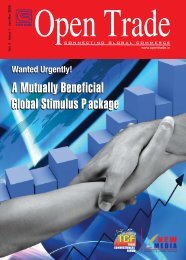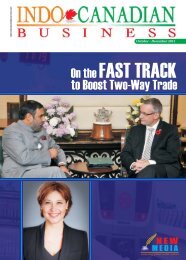Create successful ePaper yourself
Turn your PDF publications into a flip-book with our unique Google optimized e-Paper software.
AllianceIndia's Engagement in Regional Trade of its pursuits towards eventual multilateralism.AgreementsWhile India needs to maintain consistency in its negativeIndia's endeavour to foster its international trade haslists with regard to agreements with different countries tobeen well complemented by its efforts to promote effectively protect the domestic industries, it is also crucialregional trade. Target countries in India's regional trade to address the issue of non-tariff trade barriers, especiallyinitiatives cover various regions of the world. In Asia, when engaging in regional trade agreements withIndia made a foray in RTAs with an FTA with Sri Lanka in developed countries like the US or the European Union.1998. This was followed by a Comprehensive EconomicWith the recognition of the positive impact of RTAs on aCooperation Agreement (CECA) with Singapore, an FTAcountry's trade performance, India could explore tradewith South Asian Association for Regional Cooperationaccords with all major trading blocs in different regions of(SAARC) members (SAFTA) and with the members of Baythe world viz. MERCOSUR, NAFTA, EU, ASEAN, GCC/of Bengal Initiative for Multi-Sectoral Technical andGAFTA, SADC/ SACU and CIS, which could substantiallyEconomic Cooperation (BIMSTEC), a frameworkenhance India's market access and choice of competitiveagreement for FTA with Thailand and a frameworkagreement for CECA with ASEAN.imports. Moreover, India could also consider engaging inagreements with at least one of the major members of aWith the establishment of Joint Study Groups (JSGs), trade bloc in case of its inability to strike an accord with aIndia has also initiated negotiations with a number ofbloc as a whole, which could act as a potential gatewaycountries like Korea, China, Japan, Russia, Malaysia andto other markets of the bloc.Indonesia. These initiatives form an integral part of India's'Look-East Policy', which has gained substantial India could draw insights from the global trend andmomentum in recent years and has started yielding pattern of gradual shift from south-south tradedesirable results on the economic, political and strategic agreements to preferential agreements betweenfronts. India is also seriously pursuing negotiations to developing and developed countries, and exploreestablish RTAs with other developing countries located opportunities to engage in trade agreements with moreelsewhere.developed countries like US, Japan, EU. India hasIndia has in place a preferential trade agreement (PTA) initiated negotiations for a Comprehensive Economicwith MERCOSUR and with Chile; a framework Partnership Agreement with Japan and a broad-basedagreement tor FTA with the Gulf Cooperation Council trade and investment agreement with EU, which needs to(GCC); and a PTA with South African Customs Union be carried forward. An RTA with USA, with significant(SACU). India has also established JSGs with Mauritius market potential and evident complementarities couldand Israel to explore the possibility of an FTA.also prove to be beneficial for India. Such agreementscould also facilitate and enhance investment flows intoEngagement in regional trade agreements has had aIndia.significant effect over the past decade on India's tradeperformance with its partner countries. India's exports to India could also look beyond FTAs exclusively in goods toand imports from its RTA partner countries have expand the scope of agreements to incorporate services,significantly increased from 2001-02 to 2006-07. India's investment, monetary cooperation and trade logistics.trade with its RTA partner countries as a percentage of itstotal trade has shown a notable rise from 20% to 30%On the strength of its services sector, India could set upfrom 2001-02 to 2006-07.exclusive free trade agreements in services, which couldbe later expanded to trade in goods. India could widenThe Way Forward For Indiathe scope of Bilateral Investment Promotion AgreementsIt is imperative for India to assess the long-term(BIPAs) to include specific investment incentives inimplications arising out of any engagement in RTA andgrowing sectors such as infrastructure. With regard toadopt an integrated approach consistent with the long- monetary cooperation, the model of the Mercosurterm interest and potential of the economy. Engagement Structural Convergence Fund (FOCEM), which facilitatesin regional trade agreements should be one and not the transfer of funds from more developed countries to lessonly avenue for enhancing its international economic developed countries in the bloc, could be a model ofcollaboration. India needs to explore bilateral and emulation for the SAARC region, that could effectivelyplurilateral trade initiatives and effective regionalism lead to economic development and integration of thebeyond free trade agreements, however, in continuance region. 32<strong>INDO</strong>-<strong>SWISS</strong> BUSINESS + JAN-FEB 2008
















